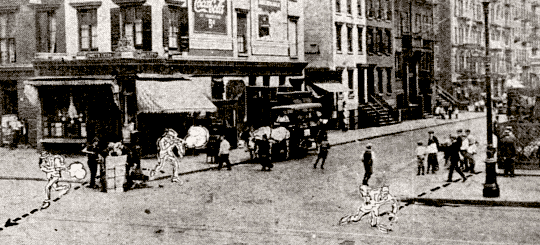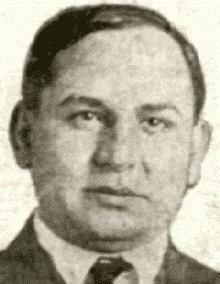On this date in 1989:
In the late morning of Friday, June 16, 1989, "Cadillac Frank" Salemme, a rising star in the Patriarca Crime Family, was walking through a House of Pancakes parking lot off Route 1 in the Boston suburb of Saugus, Massachusetts, when two gunmen opened fire on him from a passing automobile.
 |
| Salemme |
Salemme scrambled for cover and rushed inside a Papa Gino's pizza shop about thirty yards away. As he did so, the gunmen's car turned and made a second pass, firing more shots at the fleeing Mafioso.
"Cadillac Frank," wounded and bleeding, ran to the rear of the pizza shop, yelled out, "Call the police!" and collapsed near the door to the men's room. He regained his composure and his footing. Returning to the front of the shop, he sat down at the first table. He had been struck twice by the slugs fired at him - once in his chest and once in his left leg. As he waited for police and paramedics to arrive, he calmly pressed his windbreaker jacket against the chest wound to slow the flow of blood.
The authorities found the gunshot victim uncooperative. He refused even to identify himself. When asked who shot him, Salemme answered, "No one." Salemme was taken to AtlantiCare Hospital in Lynn, Massachusetts. Later in the day, doctors graded his condition as "guarded but stable."
Investigators knew of Salemme's connections to organized crime, but they weren't sure what to make of the murder attempt. Things became somewhat clearer that afternoon.
End of the Wild Guy
Shortly after three o'clock, two fishermen discovered a dead body partly submerged in the Connecticut River at Wethersfield, just south of Hartford, Connecticut. Police arriving at the scene found that the male corpse was fully clothed and still in possession of a wallet. Cards inside the wallet belonged to William P. "Wild Guy" Grasso of New Haven.
 |
| Grasso |
Further investigation positively identified the dead man as Grasso, considered the number-two man in the Patriarca organization, behind only Rhode Island-based boss Raymond "Junior" Patriarca in importance.
An autopsy revealed that Grasso had been killed by a single gunshot to the base of his skull. The medical examiner concluded that the gunshot had been fired at least twenty-four hours before the body was found.
When the news of Grasso's murder was released, Connecticut's United States Attorney Stanley A. Twardy, Jr., noted that the "Wild Guy" was "the single most influential organized crime figure in Connecticut." Twardy also commented that he could not rule out a connection between the murder of Grasso and the attack on Salemme.
Detectives kept watch for familiar underworld figures at Grasso's funeral on Tuesday, June 20. Hundreds of people filled St. Michael's Roman Catholic Church in New Haven for a Mass of Christian Burial, but no known Mafiosi were seen. The funeral cortege included fifty cars. Grasso was buried at All Saints Cemetery in his hometown, sharing a grave with his wife, who died a year earlier. He was survived by a son, three brothers and two sisters.
'Best thing that ever happened'
Grasso, a New Haven native and once a member of the New York-based Colombo Crime Family, became a member of the New England organization after serving time in Atlanta Federal Penitentiary for creating a garbage hauling monopoly in southern Connecticut. His cellmate at Atlanta was "Junior" Patriarca's father, notorious New England crime boss Raymond L.S. Patriarca. Grasso emerged from prison as a trusted aide of the elder Patriarca.
Grasso later referred to his Atlanta sentence as the "best thing that ever happened to me."
When Raymond L.S. Patriarca died in 1984, "Junior" Patriarca became boss and Grasso became underboss, directly overseeing New England Crime Family rackets in Connecticut.
Grasso aggressively expanded his territory from New Haven, across the southern portion of the state into Fairfield County, up into Hartford and beyond into the Springfield, Massachusetts, area, stepping on many mobsters' toes along the way. New York Mafiosi had long dominated in Fairfield County, several crime families had interests in Hartford, and Springfield was known to be the territory of a faction of the powerful New York-based Genovese clan.
'Kill or be killed'
Authorities quickly understood that the moves against Grasso and Salemme were designed to weaken the administration of "Junior" Patriarca. But it took some time before they could piece together just what was going on.
The loss of Grasso was keenly felt within the New England Mafia. No one within Connecticut's branch of the organization had Grasso's combination of ability and loyalty. According to FBI sources, the Patriarca administration appointed a Rhode Islander, Matthew L. Guglielmetti, to oversee rackets in the Nutmeg State. Nicholas L. Bianco, another Rhode Island resident, was elevated to the position of underboss.
In 1990, federal prosecutors began dismantling the New England Mafia through successful prosecutions. In the process, they learned that brothers Louis and Frank Pugliano, Gaetano Milano and Milano's longtime friend Frank Colantoni, Jr., participated in the killing of Grasso. Believing that Grasso was planning to murder them, they set to the job of eliminating him first.
 |
| Grasso funeral (Courant, June 21, 1989) |
They set up a phony underworld meeting in Massachusetts on June 13, 1989. With Louis Pugliano at the wheel of a van, they picked up Grasso to take him to the meeting. While driving along Interstate-91 in Connecticut, Milano fired a single shot into the back of Grasso's neck. The group deposited Grasso's body at the Connecticut River.
At his sentencing in 1991, Milano told U.S. District Judge Alan H. Nevas that he felt the killing of Grasso was necessary: "It was kill or be killed."
A like-minded group in Massachusetts was found to be behind the attempt on Salemme's life. Authorities learned that Enrico Ponzo and Vincent Michael Marino were the gunmen who attacked "Cadillac Frank."
U.S. prosecutors assembled convincing cases against the New England Mafia rebels (Ponzo was able to avoid capture until early in 2011) and much of the crime family leadership. But an important part of the story remained unknown to them and to the American public. It was unknown because agents of the FBI were keeping it secret.
FBI sparked rebellion
Years later, it was learned that some in the FBI had worked with informants within the New England underworld to create a destructive rivalry within the Patriarca Mafia organization. Seeds planted by the FBI convinced groups within the Connecticut and Massachusetts branches of the organization that the Patriarca administration was planning to eliminate them. That prompted them to act against Grasso and Salemme, and it also figured in several other murders.
Defense attorney Anthony Cardinale revealed in a 1997 affidavit that intentional FBI activities caused the plots against Grasso and Salemme and that the FBI knew of the plots but kept silent about them for a period of sixteen months. FBI improprieties were documented in the following years.
One of the mobsters involved in the FBI efforts was Angelo "Sonny" Mercurio. The FBI actively hid Mercurio's involvement in instigating the anti-Grasso plot while others were tried and convicted for it. Mercurio was never charged in connection with the killing. He died in Florida in late 2006 while in the witness protection program.
The revelations of FBI involvement and coverup led to revised sentences for a number of those convicted in the early 1990s.
Sources:
- "Garbageman backs attempt to regain 'stolen' customer," Bridgeport CT Post, Nov. 7, 1968, p. 20.
- "Police confirm reputed crime boss a homicide victim," Associated Press, June 17, 1989, apnews.com.
- Cullen, Kevin, "Two men linked to mob shot in separate attacks," Boston Globe, June 17, 1989, bostonglobe.com.
- Hays, Constance L., "A mob leader in New England is believed slain," New York Times, June 17, 1989.
- Foderaro, Lisa W., "Mob leader's slaying may signal power struggle," New York Times, June 18, 1989, p. 31.
- Mahony, Edmund, "Hundreds attend rite for Grasso," Hartford Courant, June 21, 1989, p. 1.
- Gombossy, George, "Magistrate may free mob suspects on bond," Hartford Courant, March 31, 1990, p. C1.
- Mahony, Edmund, "Two plead guilty to racketeering charges in surprise move," Hartford Courant, May 2, 1991, p. C1.
- Barry, Stephanie, "Mob killer may get out early," Springfield MA Republican, Sept. 22, 2008, masslive.com.
- Christoffersen, John, "Judge reduces mobster killer's sentence," Norwalk CT Hour, Oct. 9, 2008.
- Marcus, Jon, "Attorney says FBI encouraged mob shootings," New Bedford MA SouthCoast Today, Jan. 10, 2011, southcoasttoday.com.
- Guilfoil, John M., "Fugitive mobster found in Idaho," Boston Globe, Feb. 9, 2011, boston.com.
- Mahony, Edmund H., "The Mob in Connecticut: Grasso's reign of terror," Hartford Courant, April 26, 2014, courant.com.









